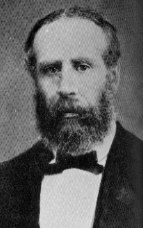Alexander McDonnell

Alexander McDonnell was born in Dublin in 1829. After graduating with Honours in Mathematics at Trinity College Dublin in 1851, McDonnell started an apprenticeship with Newall and Gordon in Westminster. He then worked as an engineer with the Newport Abergavenny and Hereford Railway where he also spent a sabbatical year in Paris. By 1861, his career had also included admission to the Institutions of Civil Engineering in Dublin, and working as a locomotive engineer with the Danube and Black Sea Railway. These posts gave McDonnell a varied and practical experience of railways.
In 1864, McDonnell returned to Ireland with his appointment as the Locomotive Superintendent of the Great Southern & Western Railway (GS&WR) of Ireland. Some have described the GS&WR's workshop practices and variety of designs in 1864 as being 'chaotic'. McDonnell quickly reformed the GS&WR workshop practices by improving both their speed and efficiency. He also introduced the practices then being used at Crewe, and standardised parts between locomotive classes. Whilst at Inchicore, McDonnell was noted for being very able and well-loved. He was also good at recognising (and employing) men who would later blossom as their careers developed. By doing all of this, McDonnell initiated the Inchicore school of locomotive engineers, who would include Sir John Aspinall, H.A. Ivatt, and R.E.L. Maunsell.
The North Eastern Railway (NER) recognised that Fletcher designed good locomotives but that they also lacked standardisation. Hence McDonnell was appointed to be the new Locomotive Superintendent in 1883, in an attempt at reorganisation and increased standardisation. By all accounts, the NER's problems were larger and far more complicated than at the GS&WR.
Accounts of the period describe the NER locomotive crews as being like a large Geordie family. Edward Fletcher, himself a Northumbrian, understood his men well and was also well liked. He was also well respected as an engineer - Fletcher's locomotives were clearly more powerful than the contemporary locomotives used by the NER's neighbours. McDonnell appears to have been unpopular from the very beginning. The trouble started when he initiated a series of relatively minor changes to the Fletcher designs, such as removing the exhaust cocks and changing the chimney shape. How dare this stranger make such changes?
The last straw was when McDonnell's first major design, the Class '38' 4-4-0 was introduced. These express locomotives were actually well-designed and well-constructed locomotives. Many of their significant dimensions were identical to Fletcher's successful Class '901' 2-4-0 design. They were also the first English locomotive to use the swing-link bogie design. However, the '38's proved to be under-powered and not free running. Some have suggested that this was because the locomotive crews did not give them a 'fair chance', although it is also possible that these deficiencies were due to their valve and motion design. The '38's were quickly taken off the main express services.
There is some evidence to suggest that McDonnell was very capable in his approaches to the NER workforce - as was the experience at Inchicore. However, both Tennant and Chairman John Dent became involved in the negotiations, and McDonnell became marginalised. Finding this position increasing untenable, McDonnell resigned in 1884. It has also been speculated that Walter Smith or Wilson Worsdell may have forced McDonnell to resign. After McDonnell's resignation from the NER, Tennant chaired a design committee to build an urgently required replacement express locomotive.
McDonnell also designed the Class '59' 0-6-0 (LNER J22) locomotives for the NER, and these actually entered service before the poorly received '38's. These came under the same kinds of criticism as the '38's, eg. bad chimney design, and lack of exhaust cocks. However, the criticism subsided after McDonnell resigned, and many of the crews would consider the J22s to be the NER's best goods locomotives of that period. It should also be noted that during McDonnell's short tenure with the NER, he managed to lay good foundations for future growth and consolidation. For the rest of its existence, the NER would benefit from McDonnell's process of standardisation and the beginning of the end of Fletcher's chaotic and non-standard systems.
McDonnell then became a boiler department manager for Lord Armstrong at Elswick, but moved to London as a Consultant Engineer some time after 1887. As a Consultant, McDonnell's clients included Thorsen Nordenfield, Sir Hiram Maxim, and a number of British-owned Brazilian railways.
McDonnell died from a stroke in 1904 on a train to Holyhead. He is buried in the family graveyard at Kilsharven near Drogheda.
Acknowledgements
Thanks to Louis Heath and Andrew Everett for providing much of the information used above.